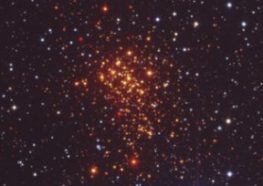Super star cluster in the neighborhood
Astronomers have spotted an amazingly compact grouping of stars in the Milky Way.
By Emily Sohn
Imagine cramming hundreds of thousands of bright, young stars into a space no bigger than our solar system. Talk about a traffic jam!
Astronomers have observed such “super” star clusters, but only in galaxies far, far away—until now. It turns out there’s a massive, super-dense star cluster right in our own galaxy, the Milky Way. It was spotted by a team of European astronomers using several telescopes at the European Southern Observatory’s La Silla site in Chile.
 |
|
The densest cluster of stars (center) that’s been detected in the Milky Way.
|
| European Southern Observatory |
Just 10,000 light-years from Earth (a mere jog across town in space terms), the cluster measures 6 light-years across. Its weight, the astronomers estimate, is at least as heavy as 100,000 suns. The cluster’s name is Westerlund 1.
The fact that the cluster exists isn’t a total surprise. Since 1961, astronomers have known that some sort of grouping of young stars lies in the constellation Ara. Because the cluster hides behind a large cloud of gas and dust, though, they had no idea how packed with stars it is.
Sensitive detectors on telescopes at La Silla helped the researchers identify more than 200 massive stars in Westerlund 1.
Each of these stars, they found, weighs 30 to 40 times as much as the sun. Some of the stars are a million times brighter. A few are so big that they would reach all the way to Saturn if you could put them where our sun is.
The telescopes in Chile were not sensitive enough to detect smaller stars in the cluster, but scientists are sure they must be there. There are probably at least a half-million more stars in Westerlund 1, they say.
The astronomers estimate that the cluster is just 5 million years old. That’s young in star years.
The discovery could help illuminate what the universe was like in its early days. Back then, studies suggest, star formation tended to happen within clusters. Collisions among stars in the super cluster could also lead to the formation of a medium-sized black hole. Right here in our own backyard.—E. Sohn
Going Deeper:
Cowen, Ron. 2005. Star packed: Super cluster is first to be detected in Milky Way. Science News 167(April 2):213-214. Available at http://www.sciencenews.org/articles/20050402/fob7.asp .
Sohn, Emily. 2005. Black hole journey. Science News for Kids (Feb. 2). Available at http://www.sciencenewsforkids.org/articles/20050202/Feature1.asp .
You can find out more about the discovery of a super star cluster in the Milky Way galaxy at www.eso.org/outreach/press-rel/pr-2005/pr-08-05.html (European Southern Observatory).







